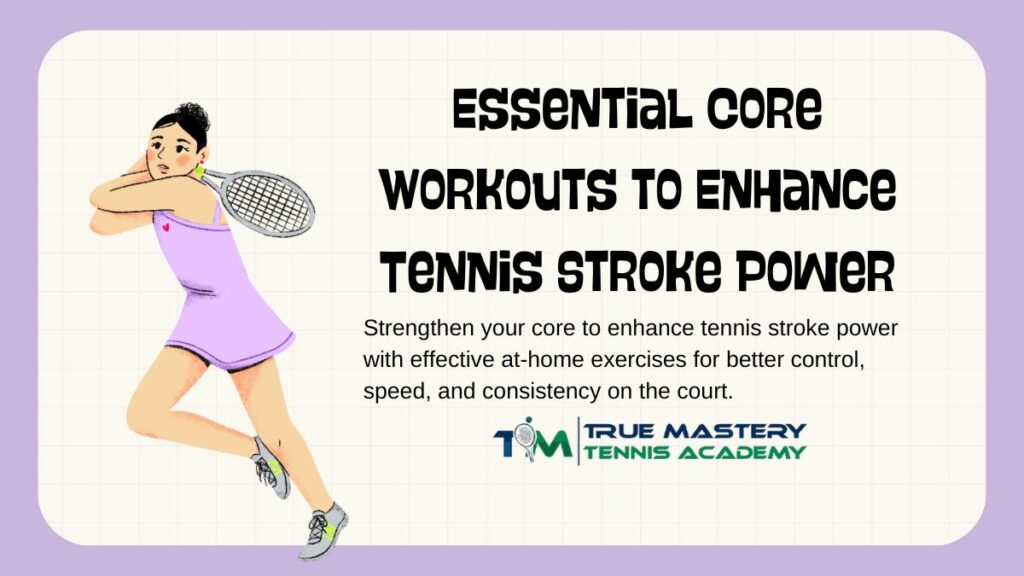Essential Core Workouts to Enhance Tennis Stroke Power
A powerful tennis stroke starts from the center of your body. The core is the engine that transfers energy from your legs to your arms, allowing you to hit more forceful and controlled shots. At-home core exercises can dramatically improve your tennis performance, whether you’re aiming for a stronger serve, a faster forehand, or a more stable backhand. True Master Tennis Academy emphasizes targeted core conditioning to build strength, stability, and rotational power for players of all levels.
Why Core Strength is Vital for Tennis
Every stroke in tennis—serve, volley, forehand, and backhand—relies on a solid foundation in the core. The core stabilizes your body during rapid changes in direction, maintains balance during lunges and pivots, and facilitates the transfer of power from your legs to your arms. Weak core muscles can limit stroke speed, reduce accuracy, and increase injury risk. By focusing on core workouts, players can unlock greater stroke efficiency and consistency while protecting the lower back and shoulders from repetitive strain.
Plank Variations for Stability and Endurance
Planks are the cornerstone of core training for tennis. A basic front plank engages the abdominals, obliques, and lower back simultaneously. Adding side planks targets the obliques, crucial for rotational power in strokes. For increased challenge, try plank with shoulder taps or plank to elbow rotations, which mimic the dynamic stabilization required during tennis movements. Performing planks consistently builds endurance, helping players maintain stroke precision even during long rallies.

Rotational Exercises for Stroke Power
Rotational strength is critical for forehands, backhands, and serves. Russian twists with a medicine ball or dumbbell improve the ability to rotate your torso explosively while maintaining balance. Standing trunk rotations with a resistance band replicate the rotational motion of tennis strokes, allowing the body to generate force efficiently from the ground up. These exercises enhance kinetic chain efficiency, ensuring that the energy produced in the legs flows seamlessly through the torso into the racquet.
Anti-Rotation Exercises to Build Core Control
Tennis players also benefit from anti-rotation exercises, which train the core to resist unwanted twisting forces during dynamic movements. Pallof presses using a resistance band strengthen the deep core stabilizers, improving stability during lateral movements and powerful strokes. Dead bugs and bird dogs are excellent at-home exercises that develop coordination and anti-rotation strength, reducing the risk of injuries while enhancing stroke control under pressure.
Dynamic Core Movements for Explosive Power
Explosive power from the core translates directly into faster, more forceful strokes. Medicine ball slams, rotational throws against a wall, and standing tosses with a partner build fast-twitch muscle response in the core. These dynamic exercises train the muscles to fire in a coordinated, explosive manner, improving shot speed and timing. Integrating these movements into your routine ensures that your core is not only strong but also responsive during high-intensity matches.
Integrating Lower Body and Core Workouts
A tennis stroke is more than just core movement; it involves a synchronized effort of legs, hips, and torso. Squats, lunges, and step-ups complement core training by developing lower-body strength, allowing the legs to generate the initial force that travels through the core to the arms. Hip bridges and rotational hip raises further strengthen the glutes and lower back, supporting efficient energy transfer and improving stroke mechanics. A holistic approach ensures maximum power without overloading any single muscle group.
Flexibility and Mobility for Optimal Core Function
Strength alone isn’t enough. Core mobility and flexibility are essential for full-range strokes. Dynamic stretches, thoracic spine rotations, and hip openers increase rotational capacity, allowing players to generate more torque while maintaining proper technique. Incorporating foam rolling or self-myofascial release before and after workouts promotes muscle elasticity, reduces soreness, and enhances recovery. True Master Tennis Academy highlights that flexibility complements strength, enabling players to achieve consistent stroke power while minimizing injury risks.
Case Study References
A research study on collegiate tennis players showed that integrating core strengthening with rotational and anti-rotation exercises increased stroke velocity and reduced lower back injuries over a 12-week period. Another study emphasized that dynamic core exercises improved stroke consistency and serve speed in junior players, demonstrating that targeted core workouts directly translate to on-court performance. These findings highlight the importance of a structured core program for all tennis players.
Designing an At-Home Core Routine for Tennis
A balanced weekly routine can include front and side planks, rotational exercises, anti-rotation drills, and explosive movements. Perform 3–4 sessions per week, alternating between static and dynamic exercises. Incorporate lower-body movements and mobility drills to complement core conditioning. Consistency and gradual progression in difficulty and resistance will yield noticeable improvements in stroke power, endurance, and stability.
Conclusion
Enhancing tennis stroke power starts at the center of your body. A strong, stable, and responsive core allows players to generate force efficiently, improve accuracy, and maintain consistency under fatigue. Combining core workouts with lower-body conditioning, rotational strength, and flexibility ensures a holistic approach to performance enhancement. True Master Tennis Academy emphasizes that these exercises, performed at home, can translate into measurable on-court improvements, empowering players to hit harder, faster, and more consistently.
To learn how to integrate these exercises into your personalized tennis program, visit our tennis lessons and programs and explore expert-guided plans tailored to your goals.
Click on the link to find out more about TM Tennis Academy’s lesson package. Chat with our head coach today!
About TM Tennis Academy
Private Tennis Lessons
Kids Tennis Lesson
Group Tennis Lessons
Whatsapp Us





4 thoughts on “Essential Core Workouts to Enhance Tennis Stroke Power”
Pingback: Is Basketball Good For Your Legs
Pingback: Evening Swimming Classes For Adults In Singapore
Pingback: Kallang Sport Centre Location & Facility Snapshot
Pingback: Jalan Besar Sport Centre Strategic Venue For Badminton Training